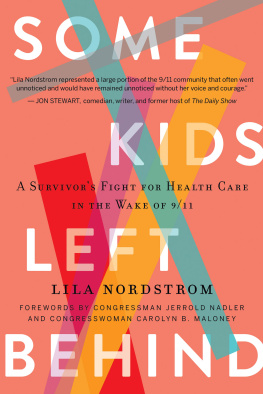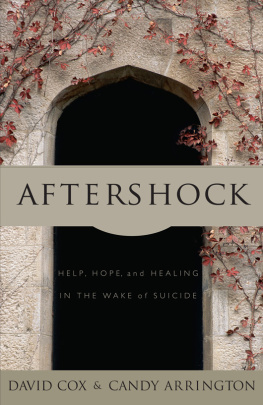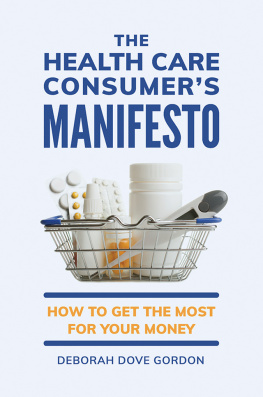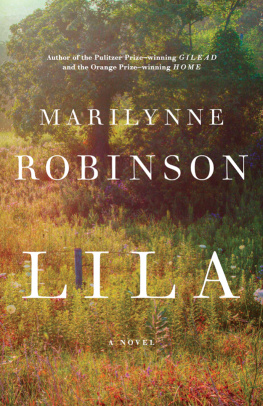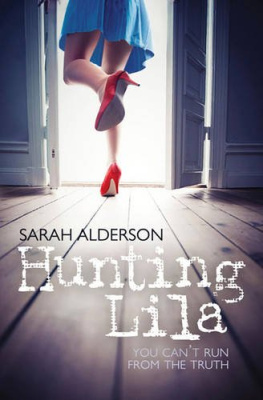SOME
A Survivors Fight for Health Care
in the Wake of 9/11
KIDS
lila nordstrom
LEFT
FOREWORDS BY CONGRESSMAN JERROLD NADLER
AND CONGRESSWOMAN CAROLYN B. MALONEY
BEHIND
Some Kids Left Behind: A Survivors Fight for Health Care in the Wa ke of 9/11
Copyright 2021 by Lila Nordstrom
All rights reserved. No part of this book may be used or reproduced in any manner whatsoever without the written permission of the publisher, except in the case of brief excerpts in critical reviews or articles. All inquiries should be sent by email to Apollo Publishers at . Apollo Publishers books may be purchased for educational, business, or sales promotional use. Special editions may be made available upon request. For details, contact Apollo Publishers at info@apollopubli shers.com.
Visit our website at www.apollopubli shers.com.
Published in compliance with Californias Propos ition 65.
Library of Congress Control Number: 2021936353
Print ISBN: 978-1-9 48062-62-6
Ebook ISBN: 978-1-9 48062-63-3
Printed in the United States o f America.
The title of this book was inspired by the headline for Kristen Lombardis story Some Kids Left Behind, which was published online by The Village Voice in Septe mber 2006.
Phot o Credits:
1. Photo by Et han Moses.
2. Photo by Et han Moses .
3. Photo courtesy of Lila Nordstrom.
4. Photo by staff photographer for Speaker Nan cy Pelosi.
5. Photo by Et han Moses.
6. Photographer unknown.
7. Photo courtesy of Lila Nordstrom.
8. Photo by Hila ry Walke.
9. Photo courtesy of the FealGood F oundation.
10. Photo by Et han Moses.
11. Photo by Michael McAuliff.
12. Photo courtesy of Lila Nordstrom.
13. Photo by Et han Moses.
14. Photo courtesy of Lila Nordstrom.
15. Photo by Et han Moses.
16. Photo by Et han Moses.
Contents
For my parents, who taught me how to rabble-rouse, and Kimberly Flynn, who advocated for me so that I could advocate f or others.
Authors Note
The story told here is based on my personal experience, and the events are written as remembered. It is not meant to be an exhaustive history of the downtown communitys battles for care. Mine is just one of many 9/11 advocacy tales, so many of which began long before my own and helped create space for my work later on.
Foreword by Congressman Jerrold Nadler
I think back upon my time at Stuyvesant High School with remarkable warmth. For so many young people, high school is a time of rich self-discovery, of youthful joy and exploration mixed with the growing maturity that arrives as you teeter on the edge of adulthood. I was no exception. It was at Stuyvesant that I pursued both politics and my interests in biology and rocketry, quickly discovering that I was far better at getting elected class president than I was at sending rockets to the moon. When I graduated in 1965, I knew immediately that I wanted to attend Columbia University so that I could stay involved in New York politics. My time at Stuyvesant had taught me what I wanted to do and who I wan ted to be.
Stuyvesant was more than just a high school for meit nurtured my passion for politics and provided me with the structure that made all the difference. But for kids like Lila Nordstrom, whose Stuyvesant experiences were instantly shattered when two planes crashed into the World Trade Center, that sense of security and exuberance was something they may never get back.
I was in Washington, DC, the morning of September 11, 2001. Upon learning the news of the attack, I immediately jumped on a train back to New York. It was a beautiful, blue-skied day, clear enough to see the burning wreckage in Lower Manhattan from the window of my train. When I think of that day, above all else, I think of the silence. The New York that greeted me when I stepped out of Penn Station was desolate and emptyno cars, no people, no vehicles, nothing. It was eerie. But I knew that forty blocks south of me, where Lila and her friends had fled from smoke and terror only hours prior, it was anything bu t silent.
As the pigeon flies, Stuyvesant High School and Ground Zero arent much more than one thousand feet apart, if that. Just three blocks. It was close enough for Lila, only seventeen years old, to watch the planes fly into the Twin Towers from the window of her classroom. Close enough for her to see, with her own eyes, the tragedy of people jumping to their deaths rather than be consumed by the flames. At the same age as I was when I was practicing for my next debate team event, Lila was forced to witness these horrific sights and then hurriedly evacuate Stuyvesant into a maelstrom of dust, chaos, and fear, running through a city gripped by shock and confusion until she was out of breath and far f rom home.
On October 9, less than a month after the dust quite literally settled in Stuyvesant, Lila and her classmates were back at school. Parents and teachers had been assured by leaders like Christine Todd Whitman, then administrator of the Environmental Protection Agency (EPA), that the air was safe to breathe and the school was safe to attend. That was a lie. The school, which had been covered in dust by the collapsed towers and then used as a morgue in the days after the attack, had never been properly cleaned. As debris was removed from Ground Zero, open trucks full of asbestos-laden materials were parked directly below Stuyvesants open windows as students sa t inside.
It took over four years for the truth to come out: the air was not clean as promised but rather contaminated with asbestos and other hazardous materials; the school and its HVAC systems had never been properly cleaned; and the carpets, auditorium seats, and other soft surfaces students encountered every day still contained hazardous materials. What was not clear then sadly is now: the federal government lied. People like Lilawho trusted leaders like Whitman and Mayor Rudy Giuliani to tell them the truthinhaled toxic air for years. Their bodies bear the con sequences.

